The Orchard at
Sage Hen Farm:
Pears
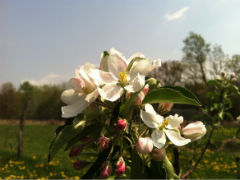
The Orchard at
|

|
|
At Sage Hen Farm in Lodi, NY, our orchard is mostly apple trees, but we have other fruit trees as well. Pears are on this page. We also grow Peaches, Plums and Cherries. At the bottom of the page are tips
for picking pears off a tree. |
||||||
| Below the pear
varieties are listed in order of ripening. In alphabetic order they are: Bosc, Clapp's Favorite, Dana Hovey, Giffard, Magness, Seckel, Tyson, Vermont Beauty, and Winter Cole. |
||||||
|---|---|---|---|---|---|---|
|
Variety Origin Date |
Fruit Size |
Skin & Flesh |
Harvest & Maturity | Merits & Faults | ||
| Giffard
(Beurre Giffard [some sources spell it Gifford]) (chance seedling) France found 1825; introduced to North America by 1850. 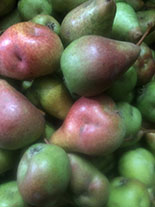
|
small,
but variable in size
classic pear shape |
yellow-green
with red cheek
white with tinges of yellow, crisp, granular, tender, very juicy |
harvest when mature in early August. | Merits:
hardy (to zone 4); one of the few pears that can be eaten almost
immediately after it is picked; moderately resistant to fire
blight; few grit cells & only at center.
Faults: tree slow to mature; fruit does not keep long. Ratings: Bull1891: 6-7/**; Bull1909: vg; Downing: "an early Pear of value," vg; Elliot: v; Hedrick: "one of the most refreshing summer fruits," vg. |
||
| Clapp's
Favorite (Clapp Favorite) (chance seedling – Bartlett x Flemish Beauty?) Dorchester, MA before 1860 
|
large
somewhat more roundish than classic pear shape |
yellow with a
red cheek
white, fine-grained, buttery, and juicy. |
harvest mid
August so so they will be ready to eat by the third week of August |
Merits:
hardy (to zone 4); tree grows well in heavy soils; tree is
spreading and drooping, making picking easier and fruit more
uniform in size; very productive.
Ratings: Faults: fruit center softens soon after ripening; does not keeps long; very susceptible to fire blight; some grit cells present. Bull1891: 6-7/**; Bull1909: g; Downing: "extremely fine and valuable," vg; Elliott: vg; Hedrick: vg |
||
| Tyson (thought to be Seckel open seedling) Jenkintown, PA before 1800  GRIN |
small to
medium
classic pear shape, but irregular |
deep yellow,
with crimson cheek, slightly russeted
creamy yellow, fine-grained; very sugary, very juicy |
harvest when mature starting in mid August | Merits:
hardy (to zone 4); very productive; fruit keeps well for earlier
ripening variety; resistant to fire-blight; few or no grit cells.
Faults: slow to mature; tall, upright grower, so must be trained; fruits can be poorly colored. Ratings: Bull1891: 7-8/**; Bull1909: vg-b; Downing: vg-b; Elliott: best; Hedrick: "best pear of its season...were the fruits larger, would rival Bartlett for market," vg |
||
| Magness (Seckel x Comice) Maryland released 1968 
|
medium
classic pear shape |
greenish
yellow with blushes of red
soft, fine-grained, rich, complex flavor, juicy |
harvest in early September so mellowed and ready to eat third week in September | Merits: tree
spreading, resistant to fire blight; excellent keeper; almost free
of grit cells.
Faults: low yield, pollen sterile |
||
| Seckel
(Sugar Pear, Shakespear) Philadelphia, PA before 1760  GRIN |
small
roundish |
brownish
yellow-green overlaid with dull red, red cheeked, and some
russetting creamy white, intensely sweet (honeyed), spicy |
harvest in mid to last September so mellowed and ready to eat starting first week of October | Merits:
hardy (to zone 4); very productive, regular cropping; self
fertile; moderately resistant to fire blight; intensely
sweet & spicy; no grit cells
Faults: thinning needed to help increase fruit size; fruit does not keep well. Ratings:
Bull1891: 10/**; Bull1909: vg-b; Bridgeman: "excellent
native...most extraordinary rich flavour"; Downing: "we to not
hesitate to pronounce this American Pear the richest and most
exquisitely flavored variety we know," Elliott: best; Hedrick:
"has no rival"; vg-b |
||
| Vermont
Beauty (Forelle open seedling?) Vt & NY around 1880 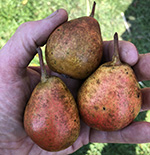
|
medium
rounder than classic pear shape |
lemon yellow
with a bright red blush & pinkish-red dots yellow-tinged, tender, melting, fine-grained; juicy |
harvest in
late September so mellowed and ready to eat starting second week
of October |
Merits: very
hardy (to zone 3); naturally spreading tree; very few grit cells.
Faults:
susceptible to scab and fireblight. |
||
| Bosc
(Beurre Bosc) Belgium circa 1800; introduced to North America in 1832 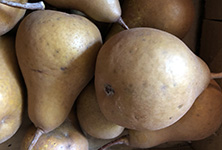
|
large
classic pear shape |
dark yellow
with streaks of russet
white, tender, very buttery, and juicy |
harvest in early to mid October so mellowed and ready to eat starting third week of October | Merits:
hardy (to zone 4); very productive; excellent keeper
Faults: susceptible to fire blight. Ratings: Bull1891: 10/**; Bull1909: vg-b; Bridgeman: "highly flavoured and delicious"; Downing: we give our unqualified praise, of the highest flavor; Elliott: best; Hedrick: "merit unqualified praise"vg-b |
||
| Dana
Hovey (Dana's Hovey, Winter Seckel) (Seckel open seedling) Roxbury, MA before 1855 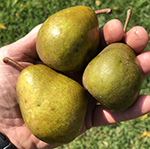
|
small
rounder than classic pear shape |
golden-yellow,
russeted
yellowish, rich, sugary, tender |
harvest in mid
or late October so mellowed and ready to eat starting in November |
Merits:
moderately heavy cropper; spreading tree; adapts to a variety of
soils; scab
and insect resistant; highly aromatic; fruit keeps well
Faults: slow to mature; susceptible to fire blight Ratings:
Bull1891: 10/**; Bull09: vg-b; Downing: "one of the
highest flavored Pears that we have known," best; Elliott: best;
Hedrick: best |
||
| Winter
Cole (Winter Nelis open pollinated) Victoria, Australia, 1880s |
small to
medium rounder than classic pear shape |
yellowish
green, dotted with russet
yellowish white, high flavored, sugary, crisp; very juicy |
harvest in mid
or late October so mellowed and ready to eat starting in December |
Merits:
heavy cropper; highly
aromatic; fruit keeps well; resistant to scab; non-browning flesh;
late blooming. Faults: slow to mature; can be biennial; susceptible to fire blight Ratings:
Hedrick:
vg |
||
|
Bull1891
= "Catalog of Fruits Recommended for Cultivation; Division I:
Fruits Mainly Adapted to Northern Localities; Section 1: Apples,"
U.S. Department of Agriculture, Division of Pomology. Bulletin,
1891 [Ratings are from 1 (very poor) to 10 (best); rating after /
indicates notation for District No. 2 that includes New York's
Finger Lakes (NR either not reported or not recommended; * known
to succeed; ** highly successful; + promising]. Revisions were
made in 1897
and 1899, but no changes were made in pear ratings. Bull1909
refers to the revision of 1909
when more traditional ratings replaced the numerical system:
g=good, vg=very good, and vg-b=very good to best. GRIN = detailed descriptions of pear varieties from the collection of the U.S. National Plant Germplasm System. Pears are part of National Clonal Germplasm Repository in Corvallis, Oregon. |
||||||
|
Tips for picking pears Ralph Waldo Emerson biographer John McAleer wrote of Emerson that "In autumn and in winter he kept pears ripening on the back of his bookshelves and, on occasion, might interrupt his work to reward himself with one. The selection was done with care since he believed there were only ten minutes in the life of a pear when it was perfect to eat." The idea is older than Emerson, and has also been attributed to an unknown French gourmand. [Thanks to quotation sleuth Garson O'Toole for tracking that quote down for me.] Most pears do not ripen well on the tree, at least as far as humans are concerned. They ripen from the inside out while on the tree, and humans don't like that. For the best eating experience, pears need to be picked when their fruit is mature but not fully ripe. Hmm? Mature in this case means slightly immature, but far enough along that that they will ripen properly. These are some tips to figure out when that moment is. Keep in mind, however, that I'm still trying to figure it out. Clues
|
|
This page written and maintained by John R. Henderson [jhenderson
@ ithaca.edu]. |